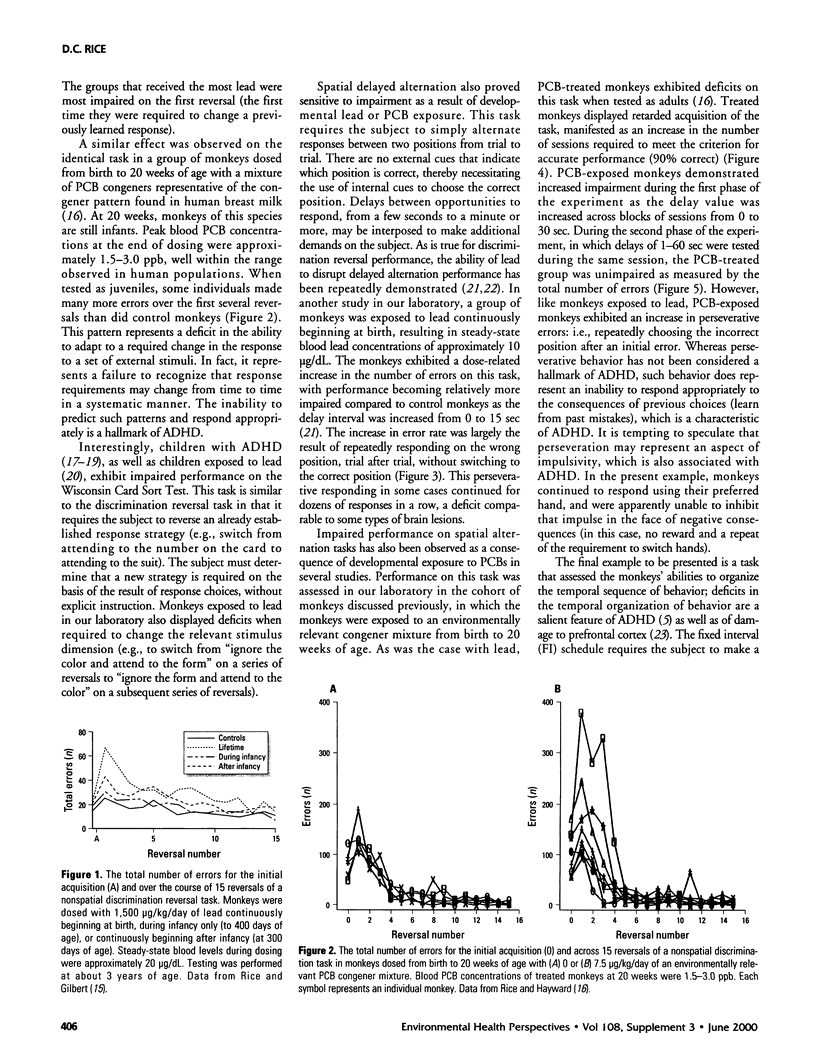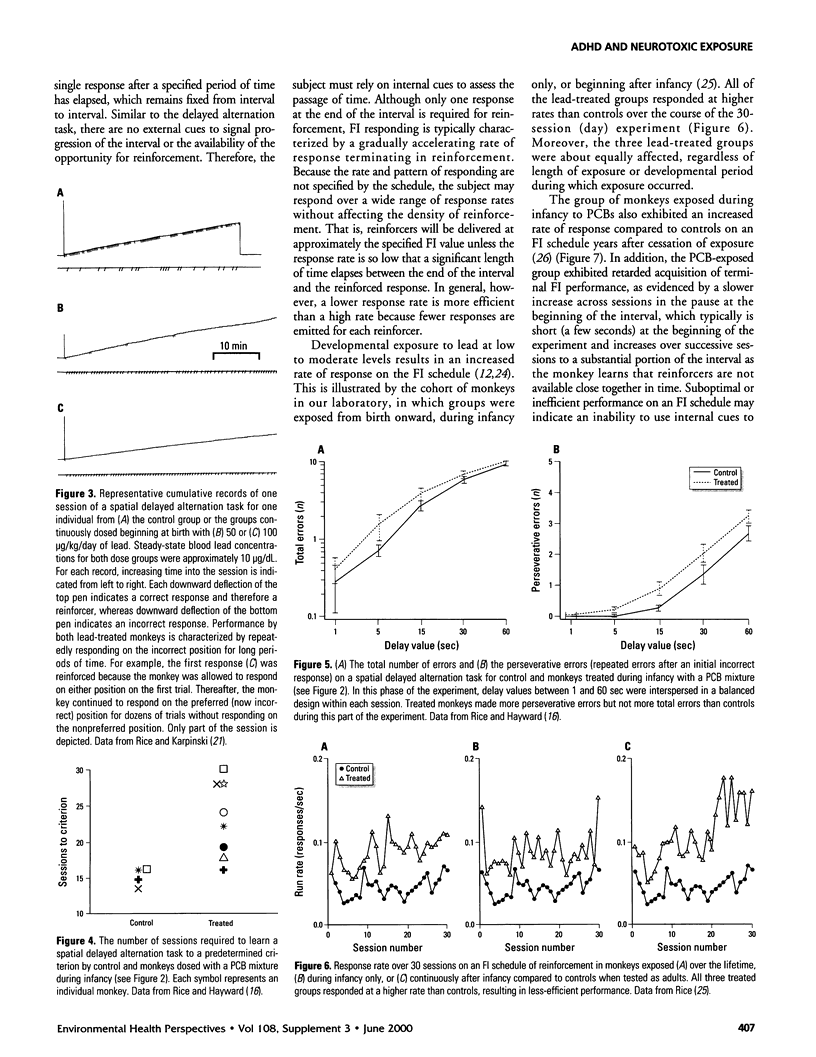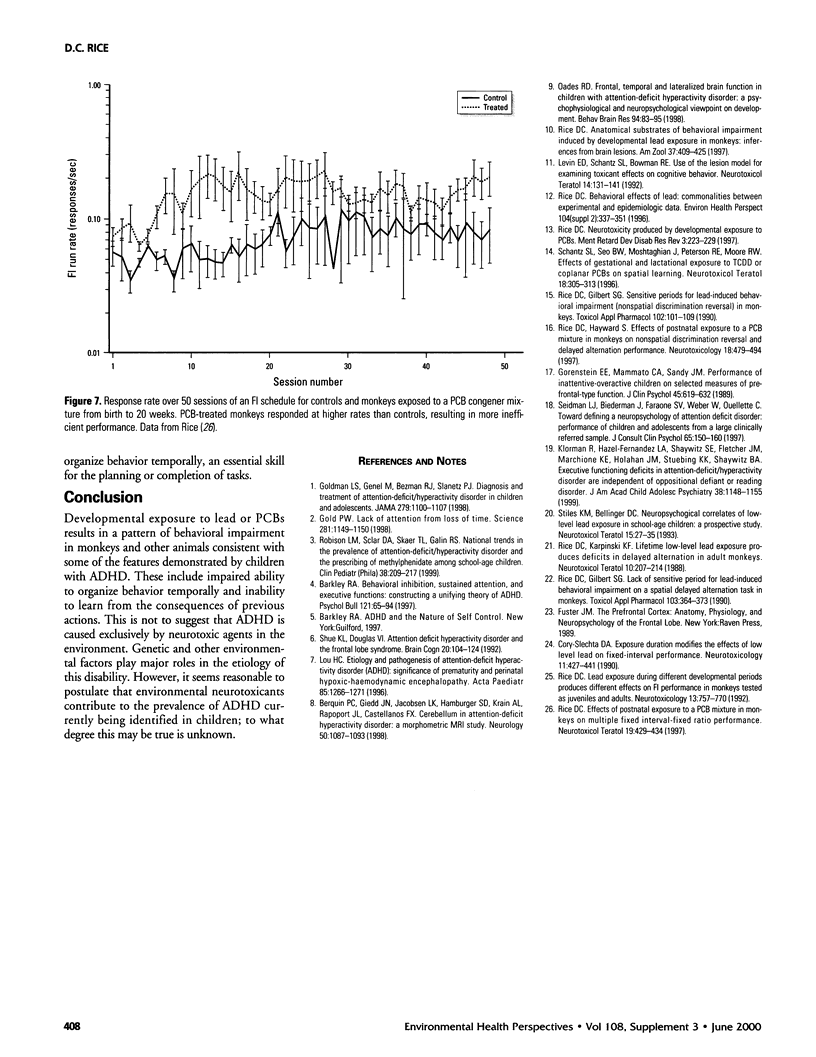Abstract
Attention deficit hyperactivity disorder (ADHD) is a disability that affects between 3 and 7% of children, with a significant number of individuals continuing to be affected into adolescence and adulthood. ADHD is characterized in part by an inability to organize complex sequences of behavior, to persist in the face of distracting stimuli, and to respond appropriately to the consequences of past behavior. There are some parallels between the features of ADHD and the behavior of monkeys exposed developmentally to lead or polychlorinated biphenyls (PCBs), as evidenced by research from our laboratory. Both lead and PCB exposure produce deficits on discrimination reversal and spatial delayed alternation performance; treated monkeys exhibit deficits in their ability to change an already established response strategy and inhibit inappropriate responses. Monkeys exposed developmentally to lead or PCBs also perform differently from control monkeys on a fixed interval schedule of reinforcement, which requires the temporal organization of behavior using only internal cues. Whereas the etiology of ADHD is multifactorial, the possibility that neurotoxic agents in the environment contribute to the incidence of ADHD warrants attention.
Full text
PDF



Selected References
These references are in PubMed. This may not be the complete list of references from this article.
- Barkley R. A. Behavioral inhibition, sustained attention, and executive functions: constructing a unifying theory of ADHD. Psychol Bull. 1997 Jan;121(1):65–94. doi: 10.1037/0033-2909.121.1.65. [DOI] [PubMed] [Google Scholar]
- Berquin P. C., Giedd J. N., Jacobsen L. K., Hamburger S. D., Krain A. L., Rapoport J. L., Castellanos F. X. Cerebellum in attention-deficit hyperactivity disorder: a morphometric MRI study. Neurology. 1998 Apr;50(4):1087–1093. doi: 10.1212/wnl.50.4.1087. [DOI] [PubMed] [Google Scholar]
- Cory-Slechta D. A. Exposure duration modifies the effects of low level lead of fixed-interval performance. Neurotoxicology. 1990 Fall;11(3):427–441. [PubMed] [Google Scholar]
- Goldman L. S., Genel M., Bezman R. J., Slanetz P. J. Diagnosis and treatment of attention-deficit/hyperactivity disorder in children and adolescents. Council on Scientific Affairs, American Medical Association. JAMA. 1998 Apr 8;279(14):1100–1107. doi: 10.1001/jama.279.14.1100. [DOI] [PubMed] [Google Scholar]
- Gorenstein E. E., Mammato C. A., Sandy J. M. Performance of inattentive-overactive children on selected measures of prefrontal-type function. J Clin Psychol. 1989 Jul;45(4):619–632. doi: 10.1002/1097-4679(198907)45:4<619::aid-jclp2270450419>3.0.co;2-m. [DOI] [PubMed] [Google Scholar]
- Klorman R., Hazel-Fernandez L. A., Shaywitz S. E., Fletcher J. M., Marchione K. E., Holahan J. M., Stuebing K. K., Shaywitz B. A. Executive functioning deficits in attention-deficit/hyperactivity disorder are independent of oppositional defiant or reading disorder. J Am Acad Child Adolesc Psychiatry. 1999 Sep;38(9):1148–1155. doi: 10.1097/00004583-199909000-00020. [DOI] [PubMed] [Google Scholar]
- Levin E. D., Schantz S. L., Bowman R. E. Use of the lesion model for examining toxicant effects on cognitive behavior. Neurotoxicol Teratol. 1992 Mar-Apr;14(2):131–141. doi: 10.1016/0892-0362(92)90061-e. [DOI] [PubMed] [Google Scholar]
- Lou H. C. Etiology and pathogenesis of attention-deficit hyperactivity disorder (ADHD): significance of prematurity and perinatal hypoxic-haemodynamic encephalopathy. Acta Paediatr. 1996 Nov;85(11):1266–1271. doi: 10.1111/j.1651-2227.1996.tb13909.x. [DOI] [PubMed] [Google Scholar]
- Oades R. D. Frontal, temporal and lateralized brain function in children with attention-deficit hyperactivity disorder: a psychophysiological and neuropsychological viewpoint on development. Behav Brain Res. 1998 Jul;94(1):83–95. doi: 10.1016/s0166-4328(97)00172-1. [DOI] [PubMed] [Google Scholar]
- Rice D. C. Behavioral effects of lead: commonalities between experimental and epidemiologic data. Environ Health Perspect. 1996 Apr;104 (Suppl 2):337–351. doi: 10.1289/ehp.96104s2337. [DOI] [PMC free article] [PubMed] [Google Scholar]
- Rice D. C. Effect of postnatal exposure to a PCB mixture in monkeys on multiple fixed interval-fixed ratio performance. Neurotoxicol Teratol. 1997 Nov-Dec;19(6):429–434. doi: 10.1016/s0892-0362(97)87364-3. [DOI] [PubMed] [Google Scholar]
- Rice D. C., Gilbert S. G. Lack of sensitive period for lead-induced behavioral impairment on a spatial delayed alternation task in monkeys. Toxicol Appl Pharmacol. 1990 Apr;103(2):364–373. doi: 10.1016/0041-008x(90)90236-n. [DOI] [PubMed] [Google Scholar]
- Rice D. C., Gilbert S. G. Sensitive periods for lead-induced behavioral impairment (nonspatial discrimination reversal) in monkeys. Toxicol Appl Pharmacol. 1990 Jan;102(1):101–109. doi: 10.1016/0041-008x(90)90087-b. [DOI] [PubMed] [Google Scholar]
- Rice D. C., Hayward S. Effects of postnatal exposure to a PCB mixture in monkeys on nonspatial discrimination reversal and delayed alternation performance. Neurotoxicology. 1997;18(2):479–494. [PubMed] [Google Scholar]
- Rice D. C., Karpinski K. F. Lifetime low-level lead exposure produces deficits in delayed alternation in adult monkeys. Neurotoxicol Teratol. 1988 May-Jun;10(3):207–214. doi: 10.1016/0892-0362(88)90019-0. [DOI] [PubMed] [Google Scholar]
- Rice D. C. Lead exposure during different developmental periods produces different effects on FI performance in monkeys tested as juveniles and adults. Neurotoxicology. 1992 Winter;13(4):757–770. [PubMed] [Google Scholar]
- Robison L. M., Sclar D. A., Skaer T. L., Galin R. S. National trends in the prevalence of attention-deficit/hyperactivity disorder and the prescribing of methylphenidate among school-age children: 1990-1995. Clin Pediatr (Phila) 1999 Apr;38(4):209–217. doi: 10.1177/000992289903800402. [DOI] [PubMed] [Google Scholar]
- Schantz S. L., Seo B. W., Moshtaghian J., Peterson R. E., Moore R. W. Effects of gestational and lactational exposure to TCDD or coplanar PCBs on spatial learning. Neurotoxicol Teratol. 1996 May-Jun;18(3):305–313. doi: 10.1016/s0892-0362(96)90033-1. [DOI] [PubMed] [Google Scholar]
- Seidman L. J., Biederman J., Faraone S. V., Weber W., Ouellette C. Toward defining a neuropsychology of attention deficit-hyperactivity disorder: performance of children and adolescents from a large clinically referred sample. J Consult Clin Psychol. 1997 Feb;65(1):150–160. doi: 10.1037/0022-006X.65.1.150. [DOI] [PubMed] [Google Scholar]
- Shue K. L., Douglas V. I. Attention deficit hyperactivity disorder and the frontal lobe syndrome. Brain Cogn. 1992 Sep;20(1):104–124. doi: 10.1016/0278-2626(92)90064-s. [DOI] [PubMed] [Google Scholar]
- Stiles K. M., Bellinger D. C. Neuropsychological correlates of low-level lead exposure in school-age children: a prospective study. Neurotoxicol Teratol. 1993 Jan-Feb;15(1):27–35. doi: 10.1016/0892-0362(93)90042-m. [DOI] [PubMed] [Google Scholar]


